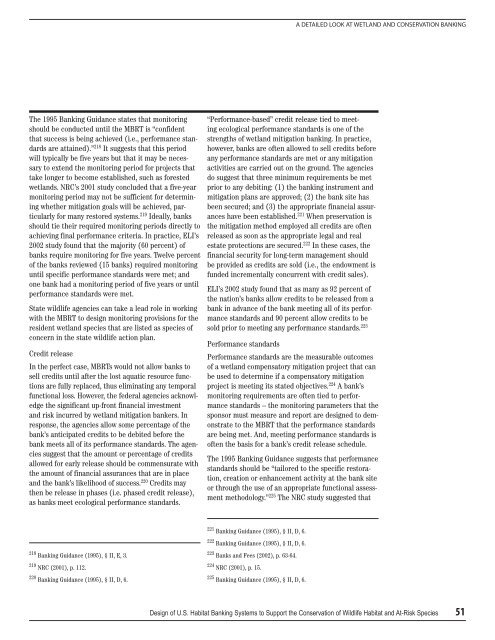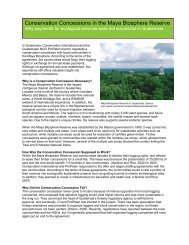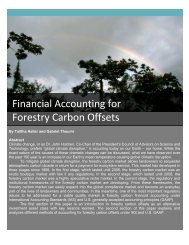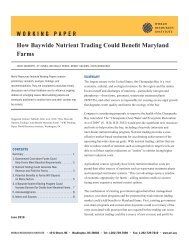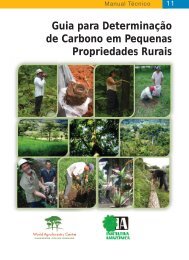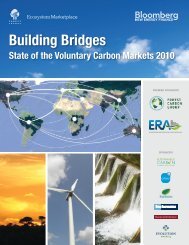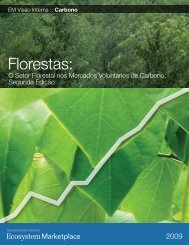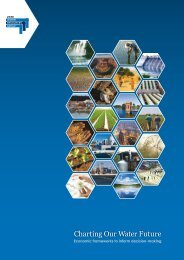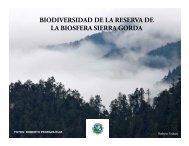Design of US Habitat Banking Systems to Support the Conservation ...
Design of US Habitat Banking Systems to Support the Conservation ...
Design of US Habitat Banking Systems to Support the Conservation ...
Create successful ePaper yourself
Turn your PDF publications into a flip-book with our unique Google optimized e-Paper software.
A DETAILED LOOK AT WETLAND AND CONSERVATION BANKINGThe 1995 <strong>Banking</strong> Guidance states that moni<strong>to</strong>ringshould be conducted until <strong>the</strong> MBRT is “confidentthat success is being achieved (i.e., performance standardsare attained).” 218 It suggests that this periodwill typically be five years but that it may be necessary<strong>to</strong> extend <strong>the</strong> moni<strong>to</strong>ring period for projects thattake longer <strong>to</strong> become established, such as forestedwetlands. NRC’s 2001 study concluded that a five-yearmoni<strong>to</strong>ring period may not be sufficient for determiningwhe<strong>the</strong>r mitigation goals will be achieved, particularlyfor many res<strong>to</strong>red systems. 219 Ideally, banksshould tie <strong>the</strong>ir required moni<strong>to</strong>ring periods directly <strong>to</strong>achieving final performance criteria. In practice, ELI’s2002 study found that <strong>the</strong> majority (60 percent) <strong>of</strong>banks require moni<strong>to</strong>ring for five years. Twelve percent<strong>of</strong> <strong>the</strong> banks reviewed (15 banks) required moni<strong>to</strong>ringuntil specific performance standards were met; andone bank had a moni<strong>to</strong>ring period <strong>of</strong> five years or untilperformance standards were met.State wildlife agencies can take a lead role in workingwith <strong>the</strong> MBRT <strong>to</strong> design moni<strong>to</strong>ring provisions for <strong>the</strong>resident wetland species that are listed as species <strong>of</strong>concern in <strong>the</strong> state wildlife action plan.Credit releaseIn <strong>the</strong> perfect case, MBRTs would not allow banks <strong>to</strong>sell credits until after <strong>the</strong> lost aquatic resource functionsare fully replaced, thus eliminating any temporalfunctional loss. However, <strong>the</strong> federal agencies acknowledge<strong>the</strong> significant up-front financial investmentand risk incurred by wetland mitigation bankers. Inresponse, <strong>the</strong> agencies allow some percentage <strong>of</strong> <strong>the</strong>bank’s anticipated credits <strong>to</strong> be debited before <strong>the</strong>bank meets all <strong>of</strong> its performance standards. The agenciessuggest that <strong>the</strong> amount or percentage <strong>of</strong> creditsallowed for early release should be commensurate with<strong>the</strong> amount <strong>of</strong> financial assurances that are in placeand <strong>the</strong> bank’s likelihood <strong>of</strong> success. 220 Credits may<strong>the</strong>n be release in phases (i.e. phased credit release),as banks meet ecological performance standards.“Performance-based” credit release tied <strong>to</strong> meetingecological performance standards is one <strong>of</strong> <strong>the</strong>strengths <strong>of</strong> wetland mitigation banking. In practice,however, banks are <strong>of</strong>ten allowed <strong>to</strong> sell credits beforeany performance standards are met or any mitigationactivities are carried out on <strong>the</strong> ground. The agenciesdo suggest that three minimum requirements be metprior <strong>to</strong> any debiting: (1) <strong>the</strong> banking instrument andmitigation plans are approved; (2) <strong>the</strong> bank site hasbeen secured; and (3) <strong>the</strong> appropriate financial assuranceshave been established. 221 When preservation is<strong>the</strong> mitigation method employed all credits are <strong>of</strong>tenreleased as soon as <strong>the</strong> appropriate legal and realestate protections are secured. 222 In <strong>the</strong>se cases, <strong>the</strong>financial security for long-term management shouldbe provided as credits are sold (i.e., <strong>the</strong> endowment isfunded incrementally concurrent with credit sales).ELI’s 2002 study found that as many as 92 percent <strong>of</strong><strong>the</strong> nation’s banks allow credits <strong>to</strong> be released from abank in advance <strong>of</strong> <strong>the</strong> bank meeting all <strong>of</strong> its performancestandards and 90 percent allow credits <strong>to</strong> besold prior <strong>to</strong> meeting any performance standards. 223Performance standardsPerformance standards are <strong>the</strong> measurable outcomes<strong>of</strong> a wetland compensa<strong>to</strong>ry mitigation project that canbe used <strong>to</strong> determine if a compensa<strong>to</strong>ry mitigationproject is meeting its stated objectives. 224 A bank’smoni<strong>to</strong>ring requirements are <strong>of</strong>ten tied <strong>to</strong> performancestandards – <strong>the</strong> moni<strong>to</strong>ring parameters that <strong>the</strong>sponsor must measure and report are designed <strong>to</strong> demonstrate<strong>to</strong> <strong>the</strong> MBRT that <strong>the</strong> performance standardsare being met. And, meeting performance standards is<strong>of</strong>ten <strong>the</strong> basis for a bank’s credit release schedule.The 1995 <strong>Banking</strong> Guidance suggests that performancestandards should be “tailored <strong>to</strong> <strong>the</strong> specific res<strong>to</strong>ration,creation or enhancement activity at <strong>the</strong> bank siteor through <strong>the</strong> use <strong>of</strong> an appropriate functional assessmentmethodology.” 225 The NRC study suggested that221 <strong>Banking</strong> Guidance (1995), § II, D, 6.222 <strong>Banking</strong> Guidance (1995), § II, D, 6.218 <strong>Banking</strong> Guidance (1995), § II, E, 3.219 NRC (2001), p. 112.220 <strong>Banking</strong> Guidance (1995), § II, D, 6.223 Banks and Fees (2002), p. 63-64.224 NRC (2001), p. 15.225 <strong>Banking</strong> Guidance (1995), § II, D, 6.<strong>Design</strong> <strong>of</strong> U.S. <strong>Habitat</strong> <strong>Banking</strong> <strong>Systems</strong> <strong>to</strong> <strong>Support</strong> <strong>the</strong> <strong>Conservation</strong> <strong>of</strong> Wildlife <strong>Habitat</strong> and At-Risk Species 51


